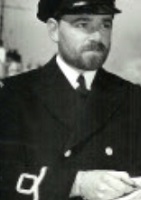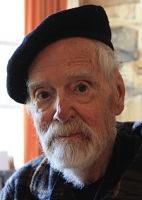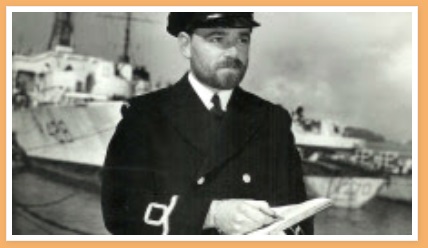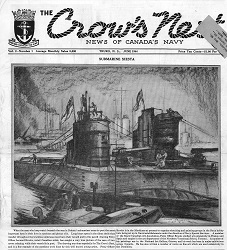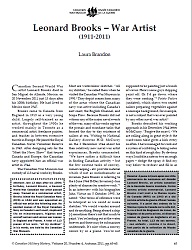|
In memory of those who have Crossed the Bar
SLt Leonard Brooks Source: fredericks-artworks.blogspot.com Credit: Globe and Mail 11 Jan 2012
Ships served in: HMCS NIOBE - Served in NIOBE as a SLt (SB), RCNVR (seniority 01 Aug 1944) (Navy List Jan / Mar 1945) RCN BARRACKS HALIFAX - Appointed to RCN BARRACKS HALIFAX 30 Aug 1945 as a Lt (SB), RCN(R) (seniority 01 Aug 1945) (Navy List Apr 1946) * Retired List as a Lt (SB), RCN(R) (seniority 01 Aug 1945) (Navy List Oct 1946) HMCS YORK (Retired List) - as a Lt (SB), RCN(R) (Navy List Jul 1952) * Last noted on the Retired List at HMCS YORK as a Lt (SB), RCN(R) (Navy List Jan 1960)
Canadian
war artist Leonard Brooks, 100, made Mexico his home
For all the ways in which Leonard Brooks was celebrated as landscape painter, war artist, dean of a Mexican art colony, creator of abstract collages and tapestries, music school director and author of eight books for the working artist the slights he felt from his native Canada proved a powerful counterforce throughout his life.
At the beginning of his career he brought energy to scenes of winter desolation, many of his pieces being watercolours that he painted outdoors with mittens and thinned-out paints. In his 30s, he became the most productive of the seven Canadian naval artists 113 works in a two-year period documenting, among other things, the daily lives of sailors and the heavy damage in bombed-out London.
His most well-known painting, Potato Peelers, was unique among the war artists for its subject matter, catching two sailors not in battle but in the unglamorous act of dinner preparation, sitting next to a couple of oil drums with a foreboding sky and sea, and a convoy of ships in the background.
By 1947, Brooks decided to move with his wife, Reva, to Mexico's San Miguel de Allende, where he remained until his death on Nov. 20 at the age of 100.
Living at first on a veteran's grant and on leave from a high school teaching job, he had originally chosen Mexico because it was a place where an artist could survive on little money, but he then fell in love with the country's light and subject matter.
He attracted other artists to join him as they practised and taught their craft in the town, which had an art school and a history of mural and fresco painting.
Brooks' violin playing, not his painting, seemed to make more of an impact on the town. Local children came to his home to learn music, with some being treated to a hot bath before their lessons.
He would eventually be hired by the Mexican government to train the next generation of professional musicians. He also held weekly pick-up concerts and inspired a chamber music festival in 1979.
Throughout his career, he would take the long drive to meet with Canadian galleries, often making stops in the U.S. to meet with curators, publishers and fellow artists. His exhibitions and monographs on painting techniques won praise from the critics, with the books and paintings he would pack in his car on each trip north selling well. But the transplanted artist felt a pall of indifference from Canada.
Things came to an emotional head in 1958, blocks away from the gallery with which he would have an on-again-off-again relationship. The Roberts Gallery was not interested in selling the pieces he had delivered. The artist, feeling spurned by a country that he still knew intimately, through its ponds, shacks, rivers and trees, and who had close friendships with and great respect from so many of its artists, broke down in tears on Toronto's Bay Street.
His feeling as an outsider had begun before he left Canada. Early in his career his resentment was aimed at the well-heeled curators running many of the museums and galleries and the trust-fund artists he would meet who didn't have to worry about sales. Later it was for art trends lapped up by the public and for those Canadians who preferred frozen wilderness over sun-scorched scenes on their national artists' canvases.
"Leonard regretted not getting recognized in Canada," said John Virtue, author of Leonard and Reva Brooks: Artists in Exile in San Miguel de Allende.
Reva, who died in 2004, also was an artist, taking photographic portraits that presented her mostly poor Mexican subjects in an honest, sometimes raw, but always dignified fashion. Her work won admiration and endorsements from the leading names in photography, including Edward Weston, Ansel Adams and Edward Steichen.
She put her aspirations aside, even when presented with key opportunities. Leonard appeared to be jealous of her meteoric rise and even gave her an ultimatum when she was offered the opportunity in 1951 to stay in California and study under an aging Weston. Nevertheless, he would later work hard to convince her to go back into a darkroom that had fallen into disuse.
With the couple not able to have children, Reva put most of her time into being her husband's manager. "Reva dedicated her whole life to Leonard," said fellow artist Sylvia Tait, who with her late husband, poet Eldon Grier, socialized with the Brooks in Mexico. "And wasn't he lucky."
His artwork, teaching, writing and antics would all help him become a magnet for other artists toying with the idea of coming down to Mexico.
Many of his experiences with fellow artists in San Miguel de Allende, from sketching expeditions to dinners discussing art, were fuelled by alcohol, splashed with wit and occasionally ruined by a raging temper.
Frank Leonard Brooks was born on Nov. 7, 1911, in Enfield, England, the first of two sons to Herb, a railways clerk, and Ellen (née Barnard) Brooks. They moved to Canada in 1913, but three years later his father had enlisted in the First World War and the young family was back in England. The six-year-old Leonard spent many months in the countryside away from the bombings and missing his father, to whom he sent drawings. His father sent back sketches from a fellow soldier, which Leonard would colour.
Coming back to Canada in 1918, Leonard was kept back a grade and mocked for his accent. His time in the school orchestra, playing violin, would offer him needed camaraderie. His love of plein-air painting was born in the woods of North Bay, Ont., to which his father was transferred in 1925. He would take his watercolour kit everywhere.
In North Bay, he also discovered a love for books and would go on to win the medal for top marks in Grade 8. A year later, after seeing a lecture on Canadian art by Arthur Lismer, in which the Group of Seven painter described his love for the natural beauty surrounding them something that Leonard had been trying to capture he decided he was going to become a painter.
His love of art would take him to England, Spain, the U.S., Greece and Italy. But it was Mexico that defined his work and where he remained for more than six decades.
While it was an inspiring and inexpensive place for two artists to live, Mexico also brought its share of difficulties.
There were inequities between the artists and the locals, which on occasion resulted in some muggings and break-ins; there was an influx of sometimes rowdy GIs following the war, which upset the clergy; and there was some violence, including the murder of a neighbouring couple and the Brooks' gardener.
The most notable incident took place in 1950, when the Brooks and six other teachers were deported at gunpoint after the owner of Brooks' former art school paid off authorities, having sought retribution for the group starting their own school following a public dispute. The incident was abetted by the American government, which accused the colony of being a haven for communists. Thankfully, Brooks had taught painting to a former Mexican munitions minister, who happened to be the brother of the country's finance minister. Not long after he got word to him, the deportation was lifted. Less than two weeks after the incident, the group was back in Mexico after being holed up in Texas.
Many people believe that if Brooks had not returned, the art colony would not have turned into the international hub that it became. "When he arrived in San Miguel, it was a sleepy little town where magic was about to happen," said Mexican-American cellist Gilberto Munguia, in Virtue's book. "Leonard brought the magic."
Leonard Brooks was still painting in his final year of life, while dealing with the after effects of cancer treatment. He leaves no immediate family.
|

